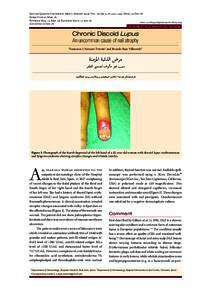Document
Chronic discoid lupus : an uncommon cause of nail atrophy.
Contributors
Ruiz-Villaverde, Ricardo., Author
Other titles
مرض الذئبة المزمنة : سبب غير مألوف لضمور الظفر
Publisher
College of Medicine, Sultan Qaboos University.
Gregorian
2018-08
Language
English
Subject
English abstract
A 45 year-old woman presented to the outpatient dermatology clinic of the Hospital Alcalá la Real, Jaén, Spain, in 2017 complaining of recent changes to the distal phalanx of the third and fourth finger of her right hand and the fourth finger of her left one. She had a history of discoid lupus erythematosus (DLE) and Sjögren syndrome (SS) without Raynaud's phenomenon. A clinical examination revealed atrophic changes associated with milky-red patches on the affected areas. The status of the toenails was normal. The patient did not show palmoplantar hyperkeratosis and there was no evidence of mucous membrane ulceration. The patient underwent a series of laboratory tests which revealed an antinuclear antibody titre of 1/640 with granular and nuclear patterns, anti-SS-related antigen A/Ro52 level of >240 U/mL, anti-SS-related antigen B/La level of >320 U/mL and rheumatoid factor level of 72.7 UI/mL. However, complement, anti-histidyl transfer ribonucleic acid synthetase, antiscleroderma 70, antiphospholipid and thrombophilia tests were normal. In addition, thyroid function was normal. Nailfold capillaroscopy was performed using a 3Gen DermLite® dermascope (3Gen Inc., San Juan Capistrano, California, USA) in polarised mode at x10 magnification. This showed dilated and elongated capillaries, increased tortuosities and avascular areas. These changes were associated with nail pterygium. Onychomycosis was ruled out by a negative dermatophyte culture.
Member of
Resource URL
Citation
Navarro-Triviño, Francisco J., & Ruiz-Villaverde, Ricardo (2018). Chronic Discoid Lupus: An uncommon cause of nail atrophy. Sultan Qaboos University Medical Journal, 18 (3), e411–412.
Arabic abstract
قدمت امرأة تبلغ من العمر 45 عامًا إلى العيادة الخارجية للأمراض الجلدية في مستشفى الكالا لا ريال ، جيان ، إسبانيا ، في عام 2017 تشكو من التغييرات الأخيرة في الكتائب البعيدة للإصبع الثالث والرابع من يدها اليمنى والإصبع الرابع من يدها اليسرى واحد. كان لديها تاريخ من الذئبة الحمامية القرصية (DLE) ومتلازمة سجوجرن (SS) بدون ظاهرة رينود. كشف الفحص السريري عن تغيرات ضامرة مرتبطة ببقع حمراء حليبية على المناطق المصابة. كانت حالة أظافر القدم طبيعية. لم يظهر على المريض فرط التقرن الراحي الاخمصي ولم يكن هناك دليل على تقرح الغشاء المخاطي. خضع المريض لسلسلة من الاختبارات المعملية التي كشفت عن عيار جسم مضاد للنواة يبلغ 1/640 مع أنماط حبيبية ونووية ، ومستضد مضاد لـ SS A / Ro52 بمستوى> 240 U / mL ، ومستضد B / La المرتبط بـ SS. مستوى> 320 U / mL ومستوى عامل الروماتويد 72.7 UI / mL. ومع ذلك ، فإن الاختبارات التكميلية ، ومضادات الهيستيدل ، وتخليق الحمض النووي الريبي ، ومضادات تصلب الجلد 70 ، ومضادات الفوسفوليبيد ، والتخثر كانت طبيعية. بالإضافة إلى ذلك ، كانت وظيفة الغدة الدرقية طبيعية. تم إجراء تنظير الشعيرات في Nailfold باستخدام 3Gen DermLite® dermascope (3Gen Inc. ، San Juan Capistrano ، كاليفورنيا ، الولايات المتحدة الأمريكية) في وضع الاستقطاب عند التكبير بمعدل x10. وقد أظهر هذا تمدد الشعيرات الدموية واستطالة ، وزيادة التعرجات ومناطق عدم الأوعية الدموية. ارتبطت هذه التغييرات بظفرة الظفر. تم استبعاد فطار الأظافر من خلال ثقافة الفطريات الجلدية السلبية.
Category
Journal articles

